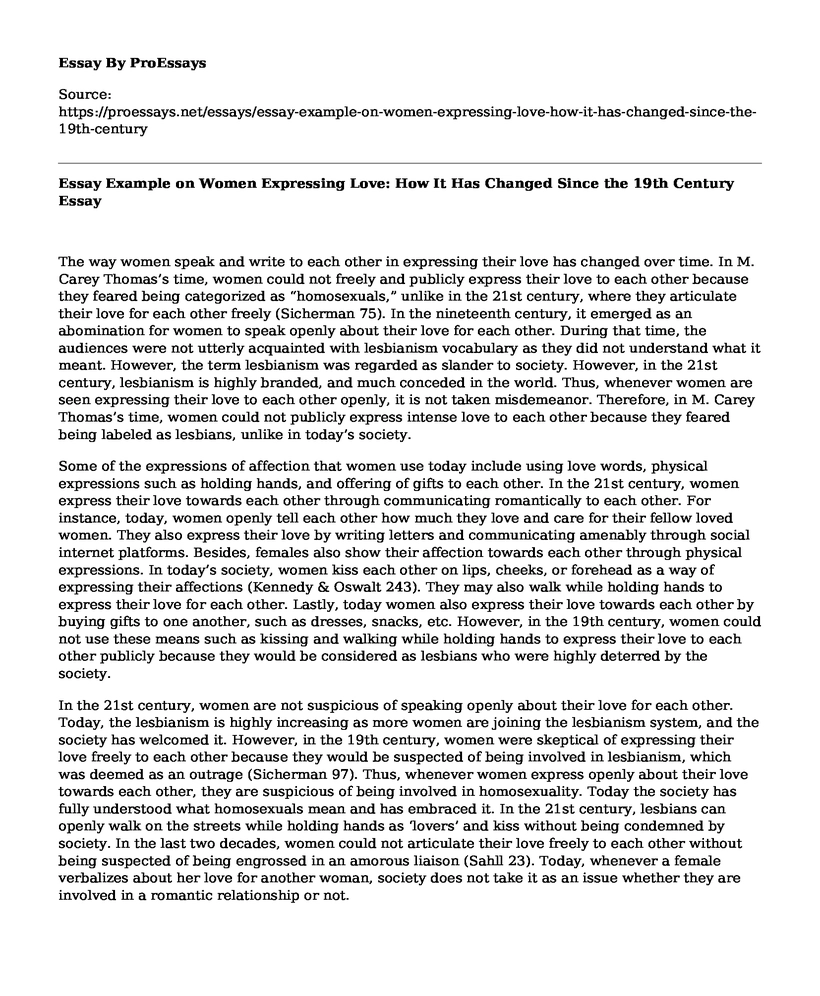The way women speak and write to each other in expressing their love has changed over time. In M. Carey Thomas’s time, women could not freely and publicly express their love to each other because they feared being categorized as “homosexuals,” unlike in the 21st century, where they articulate their love for each other freely (Sicherman 75). In the nineteenth century, it emerged as an abomination for women to speak openly about their love for each other. During that time, the audiences were not utterly acquainted with lesbianism vocabulary as they did not understand what it meant. However, the term lesbianism was regarded as slander to society. However, in the 21st century, lesbianism is highly branded, and much conceded in the world. Thus, whenever women are seen expressing their love to each other openly, it is not taken misdemeanor. Therefore, in M. Carey Thomas’s time, women could not publicly express intense love to each other because they feared being labeled as lesbians, unlike in today’s society.
Some of the expressions of affection that women use today include using love words, physical expressions such as holding hands, and offering of gifts to each other. In the 21st century, women express their love towards each other through communicating romantically to each other. For instance, today, women openly tell each other how much they love and care for their fellow loved women. They also express their love by writing letters and communicating amenably through social internet platforms. Besides, females also show their affection towards each other through physical expressions. In today’s society, women kiss each other on lips, cheeks, or forehead as a way of expressing their affections (Kennedy & Oswalt 243). They may also walk while holding hands to express their love for each other. Lastly, today women also express their love towards each other by buying gifts to one another, such as dresses, snacks, etc. However, in the 19th century, women could not use these means such as kissing and walking while holding hands to express their love to each other publicly because they would be considered as lesbians who were highly deterred by the society.
In the 21st century, women are not suspicious of speaking openly about their love for each other. Today, the lesbianism is highly increasing as more women are joining the lesbianism system, and the society has welcomed it. However, in the 19th century, women were skeptical of expressing their love freely to each other because they would be suspected of being involved in lesbianism, which was deemed as an outrage (Sicherman 97). Thus, whenever women express openly about their love towards each other, they are suspicious of being involved in homosexuality. Today the society has fully understood what homosexuals mean and has embraced it. In the 21st century, lesbians can openly walk on the streets while holding hands as ‘lovers’ and kiss without being condemned by society. In the last two decades, women could not articulate their love freely to each other without being suspected of being engrossed in an amorous liaison (Sahll 23). Today, whenever a female verbalizes about her love for another woman, society does not take it as an issue whether they are involved in a romantic relationship or not.
Conclusion
In conclusion, the way women expressed their love towards each other in the 19th century is different from the way today’s women express their love. In nineteenth-century, women could not express their affection by kissing each other publicly because they were petrified that they would be doubted of being lesbians, which was pondered as evil in society. Today, when women express their love publicly, they are envisaged of being in a romantic. Some of the expressions of affection that women use today include using love words and letters, physical expressions such as kissing and buying gifts to each other. It is not true that women are suspicious of speaking openly of their love for each other in the 21st century. Therefore, in M. Carey Thomas’s time, women were not able to express intense love for each other, unlike today, because they feared being labeled as “homosexuals.”
Works Cited
Kennedy, Donna Ann, and Sara B. Oswalt. “Is Cass’s model of homosexual identity formation relevant to today’s society?.” American Journal of Sexuality Education 9.2 (2014): 229-246.
Sahll, Nancy. Smashing: Women’s Relationship Before the Fall. Class gathering. Wellesley College. (1894): 17-27.
Sicherman, Barbara. “Reading and ambition: M. Carey Thomas and female heroism.” American Quarterly 45.1 (1993): 73-103
Cite this page
Essay Example on Women Expressing Love: How It Has Changed Since the 19th Century. (2023, Aug 27). Retrieved from https://proessays.net/essays/essay-example-on-women-expressing-love-how-it-has-changed-since-the-19th-century
If you are the original author of this essay and no longer wish to have it published on the ProEssays website, please click below to request its removal:
- Application of the Attachment Theory: The Case of Levy Family
- Essay on Psychological, Sociocultural, and Political Factors in the Development of Terrorism
- Increasing Gun-Related Violence Essay Example
- Article Analysis Essay on "Accidents on the Road"
- Essay Example on Law Enforcement: Dealing With Mental Illness Crisis
- Essay Sample on The History of Feminism: Two Waves of Women's Rights
- Bondage Breakers Foundation: Breaking Mental Health Disorders & Improving Lives







